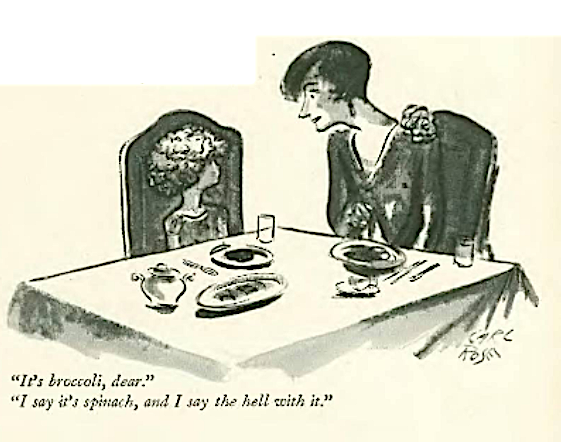How Many “One Man’s Meat” Are Enough?
Yesterday I took a late morning drive to my favorite used book store — it’s just a half hour from the Spill’s headquarters, tucked away down a rural lane. On my way I realized it might not even be open — it being a holiday. Even if it’s not open — I thought to myself — it’s a great drive. I pass by at least three old cemeteries along the way. I’ve stopped and walked through each on a hunt for — if you can believe it — Harold Ross’s mother’s grave (Thomas Kunkel, in his must-read Ross biography, Genius In Disguise, described Ross at his mother’s grave in Hillsdale NY — I still haven’t found the gravestone). A few years ago I brought six of my colleagues up to the book barn. A truly memorable visit.
Yesterday, as is my habit upon entering the barn and greeting the owner, Maureen Rodgers, I went to the “New Yorker” shelf. I immediately spied a copy of Dorothy Parker’s 1939 collection Here Lies Dorothy Parker (bought it, for a song: $4.00). Just a few books away was an edition of E.B. White’s classic One Man’s Meat (not a first edition, a later edition — but not much later!).
 I recognized the (dustjacketless) cover, but as happens so often when in a book store, I couldn’t definitively ID the copy in front of me as the same edition as the copy at home. The Spill’s copies are shown in the photo above, with the edition in question sandwiching the pocket-sized Armed Services edition (shown below). The dustjacketed copy (left) is a 4th edition; the jacketless copy is a 7th).
I recognized the (dustjacketless) cover, but as happens so often when in a book store, I couldn’t definitively ID the copy in front of me as the same edition as the copy at home. The Spill’s copies are shown in the photo above, with the edition in question sandwiching the pocket-sized Armed Services edition (shown below). The dustjacketed copy (left) is a 4th edition; the jacketless copy is a 7th).
 Without that information, and as difficult as it was to leave the book on the shelf, I passed on the Book Barn copy (will take another look at it next time I visit, if the copy is still there of course). With more than half dozen copies of One Man’s Meat at home (there are other doubles in the Spill library not shown here), I tread carefully when bringing home another. And as always when I reluctantly leave a treasured book behind, I left that copy of One Man’s Meat with the hope that someone who hasn’t read it will discover it and dive in.
Without that information, and as difficult as it was to leave the book on the shelf, I passed on the Book Barn copy (will take another look at it next time I visit, if the copy is still there of course). With more than half dozen copies of One Man’s Meat at home (there are other doubles in the Spill library not shown here), I tread carefully when bringing home another. And as always when I reluctantly leave a treasured book behind, I left that copy of One Man’s Meat with the hope that someone who hasn’t read it will discover it and dive in.
 A new visitor to this website (and/or perhaps, someone new to New Yorker history) might ask: why are you discussing E.B. White on a site dedicated to New Yorker cartoonists and cartoons?
A new visitor to this website (and/or perhaps, someone new to New Yorker history) might ask: why are you discussing E.B. White on a site dedicated to New Yorker cartoonists and cartoons?
Besides boostering (and boosting) James Thurber’s nascent New Yorker cartoons (White inked-in and submitted some of Thurber’s pencil work) White was a cartoon doctor at the magazine, most famous for tinkering with Carl Rose’s famous “Spinach” drawing (it appeared in The New Yorker, December 8, 1928). White has long been credited with coming up with the caption, but we know from a very good source (Carl Rose) that much of the caption was submitted by Rose along with his drawing. White made it zing.


I only have three copies of One Man’s Meat, which seems trifling, but for some time I’ve been on the lookout for the Armed Services Edition that was published during the Second World War. Apparently this volume was hugely popular among British soldiers.